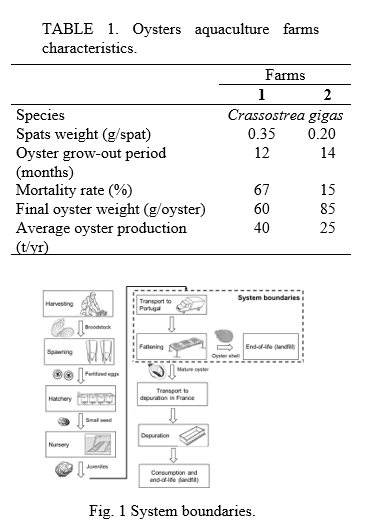ENVIRONMENTAL IMPACTS OF OYSTER PRODUCTION FROM AQUACULTURE IN PORTUGAL
Seafood has a relevant role in meeting food demand while also contributing to climate change mitigation as it typically presents lower greenhouse gases emissions than most land-based foods.
Oysters have progressively increased their role in the aquaculture sector in Portugal and still have great potential for growth. In Portugal, it represents about 25% (by volume) of the aquaculture production. In Ria de Aveiro , a lagoon in northern region of Central Portugal, oyster fattening is performed through an extensive system where the feed is exclusively natural .
Life cycle assessment (LCA) is a methodology that can be used to answer many questions that are traditionally not considered in seafood sustainability schemes.
Therefore, the aim of this work is to apply life cycle assessment (LCA) to evaluate the environmental impacts associated with the oysters produced from two aquaculture farms in Ria de Aveiro (Table 1) to identify hotspots and support different policy makers involved in the value chains of seafood production to opt for the most environmentally friendly option .
Oyster fattening is performed through an extensive system where the feed is exclusively natural. The functional unit is the production of 1 t of fresh oysters (with shell) ready to the consumer market. System boundaries include the transport of juveniles from France and the fattening stage (Fig. 1). The hatchery and nursing stage are excluded from the system boundaries. The carbon sequestration due to oyster shells growth was also included.
The characterisation factors used in this study are those suggested for conducting a Product Environmental Footprint (PEF). The fattening stage was particularly relevant for freshwater eutrophication and resource use (mineral and metals). The impacts in this stage resulted mainly from
the end-of-life at landfill of several materials used in the infrastructure, such as oyster iron racks, steel hooks and rubber anchor bands. Therefore, policies that encourage alternative end-of-life management (e.g. reuse or recycling) could improve the sustainability of oyster production.
